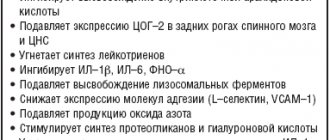Description of the drug APO-MOMETAZONE for intranasal use
Mometasone should be used with caution in case of tuberculosis infection (active or latent) of the respiratory tract, untreated fungal, bacterial, systemic viral infection or infection caused by Herpes simplex with eye damage (as an exception, the drug can be prescribed for these infections as directed by a doctor), the presence of untreated local infection involving the nasal mucosa.
With long-term intranasal use of mometasone, periodic examination of the nasal mucosa by an ENT doctor is necessary. If a local bacterial or fungal infection of the nose or throat develops, it is recommended to stop treatment and begin special treatment. Irritation of the mucous membrane of the nasal cavity and pharynx that persists for a long time is an indication for discontinuation of the drug.
When switching from GCS for systemic use to intranasal use of mometasone, special caution is required due to the possible risk of developing adrenal insufficiency. After discontinuation of systemic corticosteroids, it takes several months to restore the function of the hypothalamic-pituitary-adrenal axis.
During stressful situations, including trauma, surgery, infectious diseases or a severe attack of bronchial asthma, patients who have previously received corticosteroids for systemic use require an additional prescription of a short course of systemic corticosteroids, which are then gradually withdrawn as symptoms subside.
When switching from systemic corticosteroids, intranasal use of mometasone may result in the manifestation of concomitant allergic diseases, the symptoms of which were previously suppressed by the use of systemic corticosteroids. During this period, some patients may experience signs of withdrawal from systemic corticosteroids, including muscle and/or joint pain, depression, and fatigue, despite the fact that pulmonary function tests are stable or even improving. If signs of adrenal insufficiency occur, the dose of GCS for systemic use should be temporarily increased, and subsequently discontinued more gradually.
Patients receiving corticosteroids or other immunosuppressants should be advised to avoid contact with patients with certain infections (chicken pox, measles) and be sure to consult a doctor if such contact occurs (especially important when used in adolescents over 12 years of age).
To maintain a low potential for hypothalamic-pituitary-adrenal axis suppression, recommended doses should not be exceeded, and the dose of mometasone should be titrated to the minimum effective dose in each patient.
When using mometasone, it should be taken into account that the effect on cortisol production may vary between patients.
The occurrence of candidiasis may require appropriate antifungal therapy or discontinuation of mometasone.
Use in pediatrics
It is recommended to regularly monitor the growth of adolescents receiving long-term therapy with mometasone. If growth slows, therapy should be reconsidered in order to reduce the dose of mometasone to the minimum effective dose to control the symptoms of the disease.
In placebo-controlled clinical studies in children with intranasal use of mometasone at a dose of 100 mcg/day for a year, no growth retardation was observed.
Momat rhino 50 µg/dose 60 doses metered nasal spray
Patients with symptoms of allergic rhinitis that significantly worsen the quality of life, interfere with normal daytime activities (work, study) and disrupt sleep, can use the drug Momat Rhino Advance.
Momat Rhino Advance should not be used for more than 3 months. If it is necessary to use the drug for more than 3 months, consult a doctor.
As with any long-term treatment, patients using Momat Rhino Advance for several months or longer should be periodically examined by a doctor for possible changes in the nasal mucosa.
Azelastine hydrochloride
In some cases, when using a nasal spray, fatigue of varying severity and weakness are observed, which can also be caused by the underlying disease. Drinking alcohol can increase these effects.
Mometasone furoate
You should consult your doctor before using mometasone in patients with tuberculosis infection (active or latent) of the respiratory tract, untreated fungal, bacterial, systemic viral infection or Herpes simplex infection with eye damage (as an exception, the drug can be prescribed for these infections as directed by a doctor ), the presence of an untreated infection involving the mucous membrane of the nasal cavity.
It is necessary to monitor patients receiving intranasal corticosteroids for a long time. Possible development of growth retardation in children. If any changes occur, you must notify your doctor.
If a local fungal infection of the nose or throat develops, it may be necessary to discontinue therapy with Momat Rhino Advance and undergo special treatment. Irritation of the nasal and pharyngeal mucosa that persists for a long time may also serve as a reason to discontinue treatment with Momat Rhino Advance.
If a patient develops symptoms such as blurred vision or other visual disturbances, they should be referred to an ophthalmologist for evaluation of possible causes, which may include cataracts, glaucoma, or rare diseases such as central serous chorioretinopathy (CSCR), which have been reported since use of systemic and local glucocorticosteroids.
Patients who switch to treatment with Momat Rhino Advance after long-term therapy with systemic glucocorticosteroids require special attention. Withdrawal of systemic corticosteroids in such patients can lead to adrenal insufficiency, the subsequent recovery of which may take up to several months. If signs of adrenal insufficiency appear, systemic corticosteroids should be resumed and other necessary measures taken.
When using intranasal corticosteroids, systemic side effects may develop, especially with long-term use in high doses. The likelihood of developing these effects is much less than with the use of oral corticosteroids. Systemic side effects may vary in individual patients and depending on the glucocorticosteroid drug used. Potential systemic effects include Cushing's syndrome, Cushingoid features, adrenal suppression, growth retardation in children and adolescents, cataracts, glaucoma, and less commonly, a range of psychological or behavioral effects including psychomotor hyperreactivity, sleep disturbance, anxiety, depression, or aggression (especially in children).
During the transition from treatment with systemic corticosteroids to treatment with Momat Rhino Advance, some patients may experience initial symptoms of systemic corticosteroid withdrawal (for example, joint and/or muscle pain, fatigue and depression), despite a decrease in the severity of symptoms associated with mucosal damage nasal membranes. Such patients must be convinced of the advisability of continuing to take intranasal glucocorticosteroids. Switching from systemic to topical glucocorticosteroids may also reveal pre-existing allergic diseases such as allergic conjunctivitis and eczema that were masked by systemic glucocorticosteroid therapy.
Patients treated with corticosteroids have a potentially reduced immune responsiveness and should be advised of their increased risk of infection if exposed to patients with certain infectious diseases (eg, chickenpox, measles), and of the need for medical advice if such contact has occurred. If signs of a severe bacterial infection appear (for example, fever, persistent and sharp pain on one side of the face or toothache, swelling in the orbital or periorbital area), immediate medical consultation is required.
When using mometasone furoate in the form of a nasal spray for 12 months, there were no signs of atrophy of the nasal mucosa. In addition, mometasone furoate tended to promote normalization of the histological picture when examining biopsy specimens of the nasal mucosa.
The effectiveness and safety of mometasone have not been studied in the treatment of unilateral polyps, polyps associated with cystic fibrosis, and polyps that completely occlude the nasal cavity.
If unilateral polyps of an unusual and irregular shape are detected, especially those that are ulcerated and bleeding, it is necessary to conduct an additional medical examination.
Momat Rhino Advance contains benzalkonium chloride, which may cause irritation to the nasal mucosa.
Impact on the ability to drive vehicles and operate machinery
When using the drug Momat Rhino Advance, in rare cases, fatigue, fatigue, dizziness and weakness may develop, which can also be a consequence of the disease itself; in such cases, driving a vehicle and working with complex mechanisms should be avoided.
Overdose
There is no information available on the treatment of overdose with azelastine hydrochloride nasal spray and mometasone furoate. Information on overdose of individual components is presented below.
Azelastine hydrochloride
At the moment, there are no known cases of drug overdose with intranasal use.
Mometasone furoate
With long-term use of GCS in high doses, as well as with the simultaneous use of several GCS, inhibition of the function of the hypothalamic-pituitary-adrenal system is possible. Due to the low systemic bioavailability of the drug (
In case of overdose, consult a doctor.
Side effects Momat rhino 50 µg/dose 60 doses metered nasal spray
The list of adverse events below is based on data from clinical studies in seasonal and perennial allergic rhinitis, as well as data from post-registration use of individual components of the drug.
Seasonal allergic rhinitis
In a clinical study conducted in 560 patients aged 12 to 65 years with seasonal allergic rhinitis, 282 patients received azelastine hydrochloride + mometasone furoate nasal spray for an average of 14.94 days.
Overall, the safety profile of azelastine hydrochloride + mometasone furoate nasal spray was comparable to the profiles of the individual components used as monotherapy in the study, and was also consistent with the available published data on monotherapy with the individual components of the combination. A total of 18 adverse events associated with the use of azelastine hydrochloride + mometasone furoate nasal spray were reported in 11 of 282 patients. The most common adverse events recorded in the study were headache (5 cases) and dysgeusia (5 cases). Other adverse events were drowsiness (3 cases), lethargy (2 cases), nausea (1 case), dyspepsia (1 case) and sneezing (1 case). Most of these adverse events were mild in severity, and no serious adverse events were reported during the study.
In another clinical study conducted on 220 patients with seasonal allergic rhinitis, 55 patients received azelastine hydrochloride + mometasone furoate nasal metered spray, 1 spray in each nostril twice a day in the morning and evening, 55 patients received azelastine hydrochloride + nasal metered spray. mometasone furoate 2 injections into each nostril once a day, 55 patients dosed spray mometasone furoate and 55 patients dosed spray azelastine hydrochloride. The duration of treatment with these drugs was 14 days. During the entire study period, adverse events were identified in 51 participants (23%). During the study, the following adverse events were noted: drowsiness (0.9%), bitter taste in the mouth (3.6%), headache (2.7%), nosebleeds (1.8%), burning sensation in the nose after application (9.5%), sneezing after use (4.1%), increased appetite (0.5%), dry nose (4.1%), abnormalities in tests (0.9%), swelling of the mucous membrane nose (0.5%), nasal congestion (0.5%), rhinorrhea (0.9%), sinus arrhythmia (0.9%), redness of the hands (red spots) (0.5%), dry eyes ( 0.5%), hemorrhagic exanthema (0.5%), abnormal urinalysis (0.5%), swelling of the eyelids (0.5%), burning sensation in the eye area (0.5%) and loss of smell ( 0.5%). Mild adverse events accounted for 74.5%, and moderate adverse events accounted for 25.5% of the total number of adverse events.
Year-round allergic rhinitis
In a clinical study conducted in 150 patients with perennial allergic rhinitis, 75 patients received azelastine hydrochloride nasal metered spray + mometasone furoate, and 75 patients received combination therapy with azelastine hydrochloride nasal metered spray and mometasone furoate nasal metered spray from different devices. The duration of treatment with these drugs was 28 days. During the entire study period, 51 adverse events were reported in 23 of 150 patients (15.33%). The most common adverse events reported in the study were headache (10 cases), nosebleeds (6 cases), excessive sneezing (5 cases), and mucosal burning sensation (4 cases). Most adverse events were mild or moderate in severity, and no serious adverse events were reported during the study. A comparative analysis of the observed adverse events in the groups revealed no differences between the groups. During the study, 94.74% (18/19) of mild adverse events and 5.26% (1/19) of moderate adverse events were observed in the group of patients receiving azelastine hydrochloride + mometasone furoate nasal dosed spray.
The following are adverse drug events reported with the use of individual components of the fixed-dose combination.
In accordance with the World Health Organization (WHO), adverse events are classified based on system-organ classes according to the frequency of their development as follows: very often - ≥ 1/10; often - from ≥ 1/100 to
Azelastine hydrochloride
Common: After use, a substance-specific bitter taste may be felt (often due to improper use, namely tilting the head back excessively during use), which in rare cases may cause nausea.
Uncommon: Mild, transient irritation of the inflamed nasal mucosa may occur, with symptoms including burning, itching, sneezing and nosebleeds.
Very rare: hypersensitivity reactions (such as rash, itching, urticaria), anaphylactoid reactions, dizziness, fatigue, drowsiness, weakness (may be due to the disease itself) have been reported.
Mometasone furoate
Adverse events associated with the use of the drug (≥1%) identified during clinical trials in patients with allergic rhinitis or nasal polyposis, and during post-registration use of the drug, regardless of the indication for use, are presented below. The overall incidence of adverse events in patients treated for acute rhinosinusitis was comparable to the incidence in patients with allergic rhinitis and placebo.
Nosebleeds, as a rule, were moderate and stopped on their own, the frequency of their occurrence was slightly higher than when using placebo (5%), but equal or less than when prescribing other intranasal corticosteroids, which were used as an active control (in some of In them, the incidence of nosebleeds was up to 15%). The incidence of all other adverse events was comparable to that observed with placebo.
Infectious and parasitic diseases: often – pharyngitis, upper respiratory tract infections*
Immune system disorders: frequency not established - hypersensitivity reactions, including anaphylactic reactions, angioedema, bronchospasm, shortness of breath.
Nervous system disorders: often – headache.
Visual disorders: frequency not established - increased intraocular pressure, glaucoma, cataracts, blurred vision.
Disorders of the respiratory system, chest and mediastinal organs: very often - nosebleeds**; often - nosebleeds (i.e. obvious bleeding, as well as the release of blood-stained mucus or blood clots), burning sensation in the nose, irritation of the nasal mucosa, ulceration of the nasal mucosa; frequency not established – perforation of the nasal septum.
Gastrointestinal disorders: often – pharyngeal irritation (feeling of irritation of the pharyngeal mucosa)**; frequency not established – disturbance of taste and smell.
* - detected with a frequency of “rarely” when using the drug 2 times a day for nasal polyposis.
** — detected when using the drug 2 times a day for nasal polyposis.
When using intranasal corticosteroids, systemic side effects may develop, especially with long-term use of intranasal corticosteroids in high doses.
If you experience the side effects listed in the instructions or they get worse, or you notice any other side effects not listed in the instructions, tell your doctor.
Drug interactions
Combination therapy with loratadine was well tolerated by patients. However, no effect of the drug on the concentration of loratadine or its main metabolite in the blood plasma was noted. In these studies, mometasone furoate was not detected in blood plasma (with a sensitivity of the detection method of 50 pg/ml).
If you are using the above or other medications (including over-the-counter medications), consult your doctor before using Momat Rhino.
Concomitant use with CYP3A4 inhibitors (eg, ketoconazole, itraconazole, clarithromycin, ritonavir, medicinal products containing cobicistat) may increase the risk of systemic side effects. Coadministration of these drugs should be avoided unless the benefits of treatment outweigh the risk of systemic corticosteroid side effects. In this case, the patient should be carefully monitored for systemic side effects of corticosteroids.


